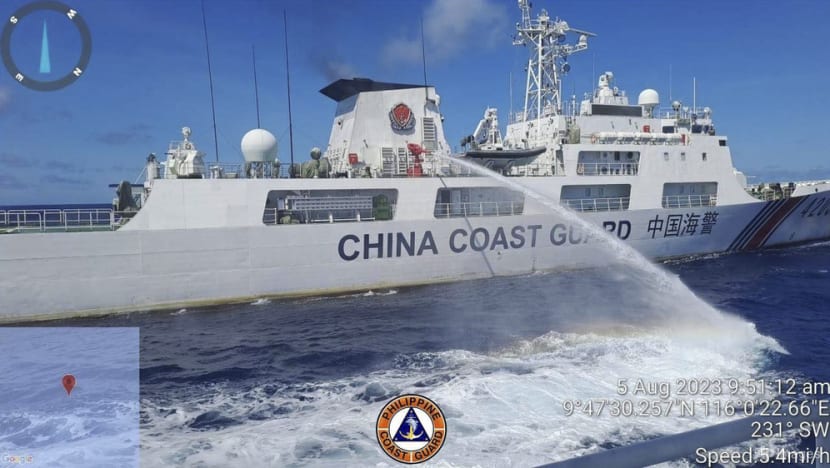CNA Explains: What a 3-day US tour of Asia says about its position on China
High-ranking American officials have been holding talks across Asia in recent days, in the face of what is seen as China’s increasing assertiveness in the Indo-Pacific.

FILE - In this handout photo provided by the Philippine Coast Guard, a Chinese coast guard ship uses water canons on a Philippine Coast Guard ship near the Philippine-occupied Second Thomas Shoal, South China Sea as they blocked its path during a re-supply mission on Aug. 5, 2023. (Philippine Coast Guard via AP, File)

This audio is generated by an AI tool.
China’s actions in the Indo-Pacific – regarded as signs of its growing aggression – have been the main topic of talks between the United States and several nations in the region in recent days, starting with Japan on Sunday (Jul 28).
The US and Japan held security talks in Tokyo before meeting the two other countries – Australia and India – that make up the Quadrilateral Security Dialogue, or Quad.
High-ranking American officials then met with their counterparts in the Philippines on Tuesday.
Present at these talks was US Secretary of State Antony Blinken, who is on a six-country tour of Asia from Jul 25 to Aug 3 that is aimed at strengthening alliances in the face of what is seen as an increasingly assertive China.
What has been taking place in the South China Sea?
Tensions over the strategic waterway, a key passage for sea-borne trade, have soared in the past 18 months following a series of escalating confrontations between Philippine and Chinese ships.
Violence broke out after a Filipino sailor lost a finger in a Jun 17 clash that Manila described as “intentional-high speed ramming” by the Chinese coast guard.
Both countries then reached a provisional agreement on Jul 21 for resupply missions in the ocean that aim to ease tensions, but Manila then accused Beijing of “mischaracterising” the arrangement.
Manila and Beijing have competing territorial claims in the South China Sea. Southeast Asian countries Vietnam, Malaysia and Brunei also claim parts of the vast ocean.
China has laid claim to more than 80 per cent of the South China Sea, after unveiling its “nine-dash” line in 2009. While a historic 2016 arbitral tribunal ruling subsequently found that this claim had “no legal basis", Beijing squarely rejected this.
What is the US doing in Japan amid these tensions?
On Sunday, foreign and defence ministers from Japan and the US announced several measures to address what they said was an “evolving security environment”, noting various threats from China including its muscular maritime activities.
The allies described China as the “greatest strategic challenge” facing the Indo-Pacific region, calling Beijing’s behaviour in the South and East China Seas “provocative”.
America said it would revamp its military command in Japan from what is largely an administrative headquarters to a joint operational one.
US Defense Secretary Lloyd Austin called this upgrade the “most significant change” to US Forces Japan since its creation. The headquarters will serve as a counterpart to the Japan Self-Defense Forces Joint Operations Command, which is set to go into effect in March 2025.
Austin said the command upgrade was "not based on any threat from China" but reflected the allies' desire to work more closely and effectively.
“The strategy of coordination that Japan and the United States are trying to enhance is really significant,” Kei Koga, Associate Professor at the Public Policy and Global Affairs Programme in Nanyang Technological University’s School of Social Sciences, told CNA’s East Asia Tonight programme.
“The coordination of military planning and policy planning together – they could actually (build on the) effectiveness of the joint cooperation among the agencies in Japan.”
Koga noted that both countries have “really similar” perspectives on China, with a long history of cooperation in terms of defence, politics and diplomacy.
What was said about China at the Quad meeting?
Foreign ministers from Australia, India, Japan and the US then met on Monday.
The four nations form the Quad – a strategic security dialogue that was resurrected in 2017 in response to China’s growing influence in the Info-Pacific.
In a joint statement that did not specifically name China, they said they were seriously concerned about “coercive and intimidating manoeuvres” in the South China Sea, including the dangerous use of coast guard and maritime militia vessels.
The Quad group revealed that they were working on a series of initiatives to maintain "the free and open maritime order", and also announced a plan to set up a new maritime legal dialogue.
Yongwook Ryu, Assistant Professor at the National University of Singapore’s Lee Kuan Yew School of Public Policy, said the statement deliberately did not directly mention China because India “is careful not to raise particular names”.
India is a member of the BRICS group of emerging economies as well as the Shanghai Cooperation Organisation, of which China and Russia are also members.
Ryu also noted that the US-Japan and Quad statements differed due to the nature of both meetings.
“The Quad is mainly about enhancing cooperation among the four countries with the hope of providing public good, whereas the US-Japan meetings are about upgrading the US-Japan security alliance, and therefore they are more free to identify specific threads and … mention specific countries,” he told CNA’s East Asia Tonight.
What is the US doing to help the Philippines?
On Tuesday, the US and Philippines then held a dialogue between their foreign and defence ministers in Manila.
The US pledged what it called an “unprecedented” level of defence funding to its longtime ally.
It will allocate an additional US$500 million to foreign military finances in the Philippines – part of US$2 billion in aid for Indo-Pacific countries that the US Congress sees as "confronting Chinese aggression".
Austin called it a “once-in-a-generation investment” to modernise the Philippines’ armed forces and coast guard.
Nevertheless, the sum is “really just a drop in the bucket of the total alliance relationship”, said Carlyle Thayer, Emeritus Professor at the University of New South Wales and the Australian Defence Force Academy.
He noted that the Philippines has shown it would like to use its own resources and diplomacy to see if it can “reach accommodation” with China, rather than invoking its defence treaty with the US. Under the pact, they agreed to support each other in the event of an armed attack.
Still, Thayer told CNA’s Asia First that the Philippines still needs the US to build up its military, which is a “long-term prospect”.
Both nations are also set to hold an inaugural cyber-digital policy dialogue in two weeks’ time, amid an increasing number of cyberattacks – many supposedly China-based – in the Philippines.
What is the significance of Blinken’s Asia tour?
Blinken’s current trip is one of the longest that a US State Secretary has made to Asia, said Erik Martinez Kuhonta, Associate Professor from the Department of Political Science at McGill University.
It also marks Blinken’s 18th visit to the continent since taking office more than three years ago.
“He’s visiting six countries, and he attended the ASEAN Regional Forum in Laos. And this is a very critical moment in terms of tensions and conflicts in East Asia and Southeast Asia,” Kuhonta told CNA938.
Blinken also met Chinese Foreign Minister Wang Yi in Laos, where he criticised Beijing for actions regarding Taiwan and the Philippines.
“The specific meeting … was about the challenges with Taiwan, but especially also with the South China Sea where Blinken is concerned and pushing for a reduction in the destabilising actions that China is undertaking,” added Kuhonta.
“So there was an effort to try to get China to realise that its actions are quite destabilising and to reduce the aggressiveness.”



















